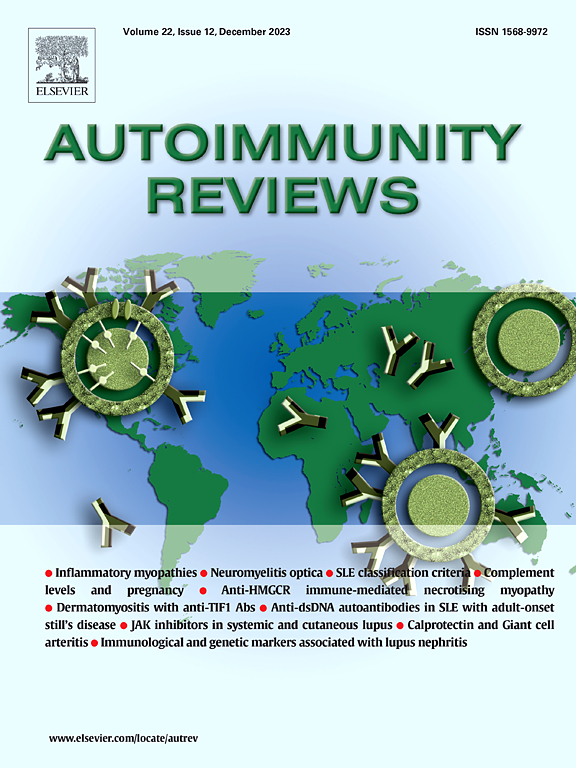Intima media thickness of the carotid artery in primary antiphospholipid syndrome: A systematic review and meta-analysis
IF 9.2
1区 医学
Q1 IMMUNOLOGY
引用次数: 0
Abstract
Background
Primary antiphospholipid syndrome (PAPS) has been associated with an increase in clinical events associated with atherosclerotic vascular disease. Intima media thickness (IMT) of carotid arteries is a surrogate marker of atherosclerotic vascular disease.
Objectives
To conduct a systematic review and meta-analysis of studies evaluating IMT and their clinical correlates in PAPS.
Methods
Systematic search of EMBASE and PubMed databases from January 2000 to December 2023; we employed random effect meta-analyses for continuous outcomes and Peto's odds ratio for rare events.
Results
The meta-analysis included 21 studies (20 case control and 1 cohort) showing that PAPS patients (n = 1103) had thicker IM than controls (n = 832) (p < 0.0001) with wide heterogeneity (I2 = 86.9 %); PAPS patients (n = 782) also had a greater pooled prevalence of carotid plaques than controls (n = 537) (13.1 % vs 2.97 %, p < 0.0001). A sensitivity analysis by meta-regression indicated that mean age, gender, disease duration, lipid profile, blood pressures, smoking and statin use all explained the heterogeneity variance; a sensitivity analysis by subgroups confirmed smoking status and statin use as explanatory variables with the addition of ethnicity.
Conclusion
Atherosclerosis of the carotid artery represents a clinical feature of PAPS in relation to the traditional risk factors and to statin use. Minimising the atherogenic risk with statins could reduce the late arterial atherothrombotic risks of PAPS.
原发性抗磷脂综合征的颈动脉内膜厚度:系统回顾和荟萃分析。
背景:原发性抗磷脂综合征(PAPS原发性抗磷脂综合征(PAPS)与动脉粥样硬化性血管疾病相关的临床事件增加有关。颈动脉内膜厚度(IMT)是动脉粥样硬化性血管疾病的替代标志物:对评估 PAPS 中内膜厚度及其临床相关性的研究进行系统回顾和荟萃分析:方法:对2000年1月至2023年12月的EMBASE和PubMed数据库进行系统检索;对连续结果采用随机效应荟萃分析,对罕见事件采用Peto几率分析:荟萃分析包括21项研究(20项病例对照和1项队列研究),结果显示,PAPS患者(n = 1103)的IM比对照组(n = 832)更厚(p 2 = 86.9%);PAPS患者(n = 782)的颈动脉斑块总发病率也高于对照组(n = 537)(13.1% vs 2.97%,p 结论:PAPS患者的颈动脉斑块总发病率高于对照组(n = 537),PAPS患者的颈动脉斑块总发病率高于对照组(n = 782),PAPS患者的颈动脉斑块总发病率高于对照组(n = 537):颈动脉粥样硬化是 PAPS 的一个临床特征,与传统的风险因素和他汀类药物的使用有关。使用他汀类药物将动脉粥样硬化风险降至最低,可降低 PAPS 的后期动脉粥样硬化血栓风险。
本文章由计算机程序翻译,如有差异,请以英文原文为准。
求助全文
约1分钟内获得全文
求助全文
来源期刊

Autoimmunity reviews
医学-免疫学
CiteScore
24.70
自引率
4.40%
发文量
164
审稿时长
21 days
期刊介绍:
Autoimmunity Reviews is a publication that features up-to-date, structured reviews on various topics in the field of autoimmunity. These reviews are written by renowned experts and include demonstrative illustrations and tables. Each article will have a clear "take-home" message for readers.
The selection of articles is primarily done by the Editors-in-Chief, based on recommendations from the international Editorial Board. The topics covered in the articles span all areas of autoimmunology, aiming to bridge the gap between basic and clinical sciences.
In terms of content, the contributions in basic sciences delve into the pathophysiology and mechanisms of autoimmune disorders, as well as genomics and proteomics. On the other hand, clinical contributions focus on diseases related to autoimmunity, novel therapies, and clinical associations.
Autoimmunity Reviews is internationally recognized, and its articles are indexed and abstracted in prestigious databases such as PubMed/Medline, Science Citation Index Expanded, Biosciences Information Services, and Chemical Abstracts.
 求助内容:
求助内容: 应助结果提醒方式:
应助结果提醒方式:


